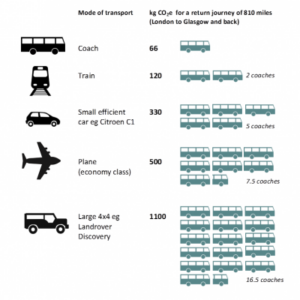Just back from holiday? Dreaming of your next trip? Concerned about the impact of trval on the climate crisis?
Here’s some info to help guide you through this minefield – mostly taken from the book ‘How Bad are Bananas – the Carbon Footprint of Everything’ (1) by Mike Berners-Lee (which by the way is well worth buying as a solidly-researched source of information on all this stuff – and a surprisingly entertaining read!).

For holidays, most of us will be looking at either flying to a destination abroad, or travelling by car as a couple, family or group. The illustration above (created using info from ‘How Bad are Bananas’) aims to provide a useful quick guide to carbon-efficient travel. As well as the emissions per journey these figures also take into account the embedded energy in the manufacture and the maintenance of the vehicle in question (although models may vary slightly). It’s not an ad for coach travel by the way!!
However it may surprise you to learn that coach travel beats most other modes of transport for single travellers – apart from cycling – but taking the train comes a very respectable second. The reason coaches win over trains is that they generally travel more slowly (requiring less energy) and the weight of vehicle per passenger of a coach is much less than a train. In terms of safety and speed, trains and planes win over all the rest.
Of course if you’re travelling as a couple, group or family, the more of you in a car, the more efficient you will be compared to other modes. But all cars are not equal.
It is quite an eye opener to realise how bad gas-guzzling four wheel drives can be, and that’s without the aircon on! But don’t let this convince you that flying is necessarily a better option – neither is compatible with a low carbon lifestyle. And the further you fly, sadly, the worse it gets. Flying economy to Hong Kong and back (12000 odd miles) would cost the earth 3400kg CO2e (more than 28 times the carbon impact of the equivalent train journey). And flying first class is almost 4 times the impact!
One of the reasons flying is so bad is that high-altitude emissions have significantly greater impact than equivalent emissions at low-altitude. It is estimated that personal flights make up a massive 8% of the carbon footprint of all consumption. In the UK only 26% of passenger flights into and out of Heathrow are commercial, the vast majority are recreational (2).
In other words this is a area where individuals can make a big personal impact – by choosing to fly less frequently and less far. For those with close relatives on the other side of the world, this may not be an option they are willing to countenance, but for the rest of us, cutting our flying is a big carbon win. To give some context, the carbon impact of a family of four flying London to Glasgow (810 miles return) would be 2000kg CO2e – which equates to one third of the carbon footprint of a new small car (1), or around 40% of an average Chinese person’s carbon footprint per year (4), or 45% of the carbon impact of leaving a low energy lightbulb on for 50 years (1). Imagine what the carbon impact of flying a family of four to St Tropez (twice as far), Malaga (3.5 times as far), or Bodrum (nearly 6 times as far) would be?
And before you think otherwise, a quick word about cruises: Although transporting stuff by ship is over 30 times more energy efficient than by air, sadly it is not the same for people. People on luxury cruises need cabins, and by and large expect bars, dining rooms, swimming pools, casinos, etc, making the carbon cost around 0.29kg CO2e per passenger per mile (3) – on a par with flying long haul.
As a family we (five Wyers) have done several holidays to France and Italy by rail and although it generally takes longer and costs more, it’s a lot more relaxed than flying or driving (and you can be a bit more generous with your packing than aircrafts allow). We would generally only hire a car at the other end if we were going to stay somewhere rural, but often we’d spend the first week in a city and do our sight-seeing on foot or by tube, bus or tram.
Recently I and several members of the samba band I belong to travelled to Coburg, deep in central Germany, for the annual international samba festival which takes place over a long weekend in July. Instead of the standard flight to Nuremberg and drive/bus/rail to Coburg, we did some research and opted to travel the whole way by train. Travelling as a group meant the costs were similar to the flights (once a taxi to/or parking at Stansted was factored in) and the journey was only a couple of hours longer. The big attraction for me was the departure time – a comfortable 7am train from Hitchin instead of 4am start for the airport.
But by far the best thing was that we ended up with an adventure! Sitting around a table with plenty of leg room, lots of time to chat or snooze, looking out of the window at beautiful scenery, receiving essential tips from helpful passengers, hilarious scoots from platform to platform, an ancient replacement bus service half way through the journey, an unplanned beer stop at Koln station bar (we missed our train and had an hour to kill!) and finally a train that split with us on the wrong end until the last minute! This particular journey was a bit of a marathon due to an earlier derailment but we all came out of it happy-drunk with exhaustion and the spirit of achievement! For anyone who has spent meaningless hours stranded at an airport, I can thoroughly recommend an eventful train ride in preference, and the return journey went like clockwork.
For those who wish to minimise their carbon footprint, but for whatever reason cannot avoid high impact journeys, we will be looking at the other big ways of reducing your carbon footprint in future weeks.
For thoroughly researched and fantastically useful info on booking and travelling on European and trans-continental trains (and ferries) please visit ‘The Man in Seat 61’
For more info on carbon footprints please buy or borrow Mike Berners-Lee’s book ‘How Bad are Bananas’ or read some of the Guardian’s excerpts online. Although the book and articles were published in 2010, broad principles still apply (as Mike confirms in his latest book ‘There is no Planet B’ – also a good read).
Vicky Wyer August 2019
1 Berners-Lee, Mike. (2010), How Bad are Bananas The Carbon Footprint of Everything. London. Profile Books Ltd
2 The Bottom Line. (2019). The Future of Commercial Aviation, BBCR4, 27 July
3 Berners-Lee, Mike. (2019). There is no Planet B. Cambridge, New York. Cambridge University Press
4 EDGAR database (2018) European Commission and Netherlands Environmental Assessment Agency calculates the latest recorded per capita emissions for China as 7700kgCO2e. As roughly one third of China’s emissions are the result of production of stuff for Western consumption, this leaves two thirds of 7700kgCO2e as a reasonable figure for the average Chinese person’s carbon impact.
